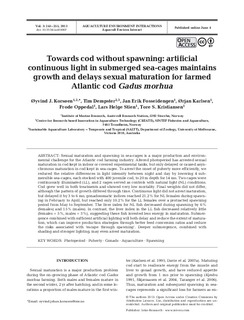| dc.contributor.author | Korsøen, Øyvind Johan | |
| dc.contributor.author | Dempster, Tim | |
| dc.contributor.author | Fosseidengen, Jan Erik | |
| dc.contributor.author | Karlsen, Ørjan | |
| dc.contributor.author | Oppedal, Frode | |
| dc.contributor.author | Stien, Lars Helge | |
| dc.contributor.author | Kristiansen, Tore S. | |
| dc.date.accessioned | 2013-08-19T10:20:31Z | |
| dc.date.available | 2013-08-19T10:20:31Z | |
| dc.date.issued | 2013-06-04 | |
| dc.identifier.citation | Korsøen ØJ, Dempster T, Fosseidengen JE, Karlsen Ø, Oppedal F, Stien LH, Kristiansen TS (2013) Towards cod without spawning: artificial continuous light in submerged sea-cages maintains growth and delays sexual maturation for farmed Atlantic cod Gadus morhua. Aquacult Environ Interact 3:245-255 | no_NO |
| dc.identifier.issn | 1869-7534 | |
| dc.identifier.issn | 1869-215X | |
| dc.identifier.uri | http://hdl.handle.net/11250/109187 | |
| dc.description.abstract | Sexual maturation and spawning in sea-cages is a major production and environmental challenge for the Atlantic cod farming industry. Altered photoperiod has arrested sexual maturation in cod kept in indoor or covered experimental tanks, but only delayed or caused asynchronous maturation in cod kept in sea-cages. To arrest the onset of puberty more efficiently, we reduced the relative differences in light intensity between night and day by lowering 4 submersible sea-cages, each stocked with 400 juvenile cod, to 20 m depth for 14 mo. Two cages were continuously illuminated (LL), and 2 cages served as controls with natural light (NL) conditions. Cod grew well in both treatments and showed very low mortality. Final weights did not differ, although the pattern of growth differed through time. Continuous light did not arrest maturation, but delayed it by 3 to 6 mo; gonadosomatic indices reached 21.2% for NL females during spawning in February to April, but reached only 10.2% for the LL females over a protracted spawning period from May to September. The liver index for NL fish decreased during spawning by 6% (females) and 15% (males). In contrast, the liver index in the LL fish decreased relatively little (females = 5%, males = 3%), suggesting these fish invested less energy in maturation. Submergence combined with sufficient artificial lighting will both delay and reduce the extent of maturation, which can improve production strategies through better feed conversion ratios and reduce the risks associated with ?escape through spawning?. Deeper submergence, combined with shading and stronger lighting, may even arrest maturation. | no_NO |
| dc.language.iso | eng | no_NO |
| dc.publisher | Inter-Research | no_NO |
| dc.title | Towards cod without spawning: artificial continuous light in submerged sea-cages maintains growth and delays sexual maturation for farmed Atlantic cod Gadus morhua | no_NO |
| dc.type | Journal article | no_NO |
| dc.type | Peer reviewed | no_NO |
| dc.subject.nsi | VDP::Agriculture and fishery disciplines: 900::Fisheries science: 920::Aquaculture: 922 | no_NO |
| dc.source.pagenumber | 245-255 | no_NO |
| dc.source.volume | 3 | no_NO |
| dc.source.journal | Aquaculture Environment Interactions | no_NO |
| dc.source.issue | 3 | no_NO |
| dc.identifier.doi | 10.3354/aei00067 | |
